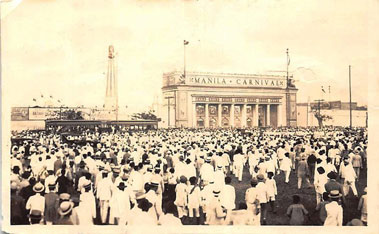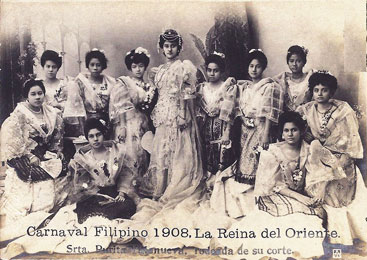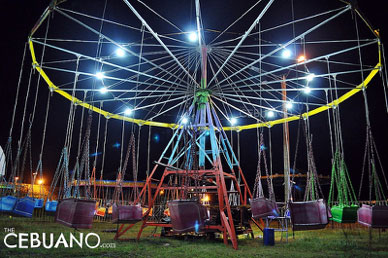Did I Stay Too Long at the Fair?
/I wanted the music to play on forever
Have I stayed too long at the fair?
I wanted the clown to be constantly clever
Have I stayed too long at the fair?
I brought me blue ribbons to tie up my hair
But I couldn't find anybody to care
The merry-go-round is beginning to slow now
Have I stayed too long at the fair?
The music has stopped and the children must go now
Have I stayed too long at the fair?
By William C. Barnes, Lyrics © Universal Music Publishing Group, 1966
The karnabals or peryas (fairs) of the 20th century are a hold-over from the American era in the Philippines when early fairs were held in Manila, with the homecoming queens of the 1910s and the 1920s. Of course, the American fairs, in turn, came from the expositions and kermesses (Dutch/French for “festival”) of Europe. Once again, hallowed institutions of western culture were passed on to the people of the Pearl of the Orient Seas.
Of the shameful versions of that genre, the most prominent was that gigantic Igorot Village attraction at the Philippine Exposition at the World’s Fair in St. Louis in 1904.
The Philippine Exposition part of that World’s Fair was a big deal at the time. There were six “villages” showcasing 40 different tribes, spread out over 47 acres, featuring an imported cast of 1,200 natives!
In hindsight, I think too much has been made of the “primitive” state of that Igorot Village exhibit in 1904. For one, it was only one of six different “villages.” For another, since they could not import the rice terraces of Banaue, then it was an authentic representation of how people in one region of the Philippines lived (as the poster on the right proclaims, “Better than a Trip through the Philippine Islands). Neither was it an any more shameful than the whole “primitive Tasaday” hoax of the 1980s Marcos era. The whole Tasaday travesty was perpetrated on a supposedly more sophisticated world and hatched by a Harvard-educated, aristocratic Filipino-mestizo, Manda Elizalde, in cahoots with his patroness, Imelda Marcos.
The St. Louis Fair also featured exhibits of art works by European-schooled artists like Juan Luna and Felix Resurrecion Hidalgo, to show off the “finer, more civilized” aspects of life in the Islands. It was only years later, from the viewpoint of us supposedly more educated/ enlightened Filipinos that we reeled with horror from the Igorot Village episode. Hey, at least over 1,000 Igorots got a free trip to America over a century ago. No visa and transportation fare problems. And many of those participants even got to stay and have new lives at the start of an American century, 70, 80 years before us, before TNTs and “undocumented aliens” became controversial.
Likewise, the more ungrateful and hypocritical among the Filipino intelligentsia tend to forget that in those same early years, the new Mother USA was also sending a few hundred pensionados, the best and brightest of the young crop of Filipinos from the best families to the better colleges in the US to acquire higher degrees and help establish the infrastructure for a more advanced, functioning society like the US when they returned home. (My grandfather, Dr. Arturo del Fierro Garcia, was one of the early pensionados with the class of 1904.)
But those are stories for another day. I merely wanted to illustrate that there are always at least two sides to every story. Back to the more positive aspects of the American legacy on the Philippine soul…
The Grand Manila Carnivals of Yore
A year after 1904, while the “kinder” American rule was in full bloom, the Manila Carnival became an annual high point of social life in Manila and certainly, by the snobby rules of the Filipino ruling class, it did not include anything as gauche as a “primitive village.”
The high point of those early Manila carnivals was the crowning of the Queen(s) from among the daughters of leading and up-and-coming families with “society” ambitions, who could be introduced properly to Manila society. In the Fair’s early editions, there were two Queens: (one each for the, one might say, bipolar personality of the then-Philippine Islands. There was a Queen of the Orient (the pure-blooded Filipina) and a Queen of the Occident (from the Caucasian crowd of Manila society.)
And this is where we trace the Filipinos’ adulation for their beauty queens. It’s nothing new, more than a century old as a matter of fact, and again, it’s a legacy from Uncle Sam – for better or for worse.
From a peaceful time in Manila in 1916, when the dual Queen titles were still being given out (with the Occidental Queen being presented below) . . .
“Royal” frivolity reigned in Manila while the war in Europe was still raging, and the colonial US master, would belatedly plunge into that continental conflagration.
CROWNED AND CAPED. The winning 1924 Carnival Queen, Trinidad Fernandez of Palawan, attended by her King Consort and princesses, was crowned in an elaborate evening affair, with pomp and pageantry befitting a new nobility.
Of course, the two halves of Manila’s soul and racial mix collide in today’s half-breed beauty queens we treasure, like Catriona Gray, Pia Wurtzbach, Megan Young, Karla Henry, etc., to name a few of the recent international crown title-holders.
(Thanks to Alex de Castro’s photos and excellent documentation of those grand Fairs that were ushered in with the smell of the new American century.)
A Fun Time Could Be Had By All
A less grand legacy from that whole American milieu of amusement parks and the so-called Midway, were what the average Filipinos enjoyed -- the peryas or the karnabals. I remember the lights and the rides. The signature icon of a perya was the Ferris wheel or chobibo, its most imposing structure. The Ferris wheel and the carousel in a karnabal are two inheritances from the time of Yankee rule. Nothing screams “American culture” more than those garish rides recreated from fairs in the US heartland.
The Ferris wheel or the chobibo!
One of the great things about those small-time fairs of my youth was that, in my limited ken, there seemed to be something for everyone to enjoy. There were the other rides:
I remember this as the “caterpillar” ride.
Technically, this is the “Skydiver,” but I recall it as the “Whirlygig.”
Whimsical games of chance or luck.
The Ball or Cage of Death
The more primitive version wherein the motorcycle spun horizontally on the vertical walls!
Game of chance, with guinea pigs or rabbits running into the little marked houses (in place of the cards in the photo) on which you placed your bets.
And then there were the freak shows and occasionally a magic show as well. One encountered all sorts of hybrid, half-human/half-animal combinations. I remember most were “Babaeng-Gagamba” (Spider-Woman) and Ang Babaeng-Sawa (half-woman, half-snake creature). I could never quite figure out how they created that illusion. There were also Babaeng Serena (the mermaid) and Taong Pinaglihi sa Palaka (human conceived after a frog -- I guess the precursor to your Frog-prince or a failed test tube baby). I could not find photos from the fairs of the 1950s that I knew but following are of more recent vintage.
Azuma, Ang Babaeng Sawa (half-snake, half-human creature)
I was really fascinated by the half-woman-half-snake.
A snake-handler’s tent (Photo courtesy of Sidney Snoeck).
Rodney, the Kangaroo Boy, ended up in jail for other offenses (Photo courtesy of Sidney Snoeck).
Or the Human Penguin (the story of Angelito Refugia)
The Tawdrier, Seamier Side
The “freak” side shows that exhibited disfigured and malformed persons, were the seamier side of a venue that presented itself as a happy place where “dreams come true.” The Elephant Man (and on a fictional basis, Mask, all over again) comes to mind when those on whom nature has played cruel tricks are taken advantage of for a quick buck. Yes, these freak shows were “dehumanizing,” but then again, how worse off would these unfortunate brethren of ours be without the carnival settings? Years ago, society and government did not give a lick about them.
In 1997, Kara David produced and hosted an excellent documentary on the phenomenon of the vanishing “freak shows,” to which I ask: which caught up first with Filipino perya operators -- conscience or political correctness? The law or a fading box-office?
At the fairs and carnivals of a century ago, everything used to be thrown in. In the Paris Universal Exposition of 1900 and St. Louis Exposition of 1904, the Olympic Games (as we know them today) were added as a side show. Larger cities and towns tie in their major holidays with carnival time: New Orleans and Mardi Gras, Carnavale in Rio de Janeiro, Venice and many German cities in Europe.
Here are just two festive Holy Week celebrations in the Philippines: in Baluiag, Bulacan;
the great Masskara Festival in Bacolod in October, which is equal to the Carnaval of Rio in lavishness and now nearing the reputation of the Moriones Festival of Marinduque.
Eventually, carnivals, the Big Top, the Midway, always had a seamier underside, which is why a dreamer like Walt Disney was forced to conceive of a cleaner, more wholesome setting – the amusement park – where he would not be afraid to take his young daughters. That dream evolved into the giant Disney-Worlds today. There are four Disney parks in Asia alone -- Tokyo Disneyland (the oldest outside the USA), one each in Hong Kong and Shanghai, and Tokyo DisneySea, the nautically themed park in Japan—to choose from.
Manila now has its own, full-fledged, year-round carnival, Star City, in Pasay City near the Mall of Asia and the City of Dreams. It has all the standard rides of the Midway, and while not as themed or versatile as a Disneyland park, it at least offers a reliable source of amusement for Manilans seeking some fun and breaks from their humdrum lives.
Then there is the failed, never-opened amusement theme park in Lemery, Batangas. I think there is nothing sadder than seeing a place where dreams are supposed to “come true” fall flat on its face even before the gates opened. Due to circumstances beyond their control, the Japanese developers ran out of money before it could be completed. There wasn’t even enough money to tear it down properly. In the meantime, it will just rot and decay. Are there no other takers?
A Persistent, Vexing Memory
One somewhat lingering memory I have of those childhood perya days was the loss of a small leather coin purse. I was too young back then, at 9 or 10, to carry a full-sized man’s wallet, so someone had given me this nifty leather coin purse crafted of fine, brown (I guess, Corinthian?) leather, and hand-made in either Italy or Switzerland. I felt so privileged to carry my Php2.00 fair allowance in it. But then, in probably the last visit to a perya, I lost the precious purse and I think some 50 centavos in it. Not that it mattered much in the larger scheme of things, but I pride(d) myself on not losing things. I believe I was enchanted to distraction by the perya, and I had somehow dropped it somewhere. That memory has taken so long to extinguish. I suppose it signaled the end of innocence as well.
In any case, summer is still in full swing. The festivals, karnabals and county fairs are out in force. Have a little cotton candy, grab the brass ring and the stuffed Barney toy, but don’t stay too long at the fair. It’s later than you think.
Sources:
http://vilascountyfair.com/index.php/history-of-ferris-wheels/
https://www.townandcountry.ph/people/heritage/manila-carnivals-a2087-20171220-lfrm8
https://www.facebook.com/groups/fanhs/
https://pop.inquirer.net/34685/fantasy-world-abandoned-theme-park-disney-world-of-ph
Myles A. Garcia is a Correspondent and regular contributor to www.positivelyfilipino.com. His newest book, “Of Adobe, Apple Pie, and Schnitzel With Noodles – An Anthology of Essays on the Filipino-American Experience and Some. . .”, features the best and brightest of the articles Myles has written thus far for this publication. The book is presently available on amazon.com (Australia, USA, Canada, Europe, and the UK).
Myles’ two other books are: Secrets of the Olympic Ceremonies (latest edition, 2016); and Thirty Years Later. . . Catching Up with the Marcos-Era Crimes published last year, also available from amazon.com.
Myles is also a member of the International Society of Olympic Historians (ISOH) for whose Journal he has had two articles published; a third one on the story of the Rio 2016 cauldrons, will appear in this month’s issue -- not available on amazon.
Finally, Myles has also completed his first full-length stage play, “23 Renoirs, 12 Picassos, . . . one Domenica”, which was given its first successful fully Staged Reading by the Playwright Center of San Francisco. The play is now available for professional production, and hopefully, a world premiere on the SF Bay Area stages.
For any enquiries on the above: contact razor323@gmail.com
More articles from Myles A. Garcia






















